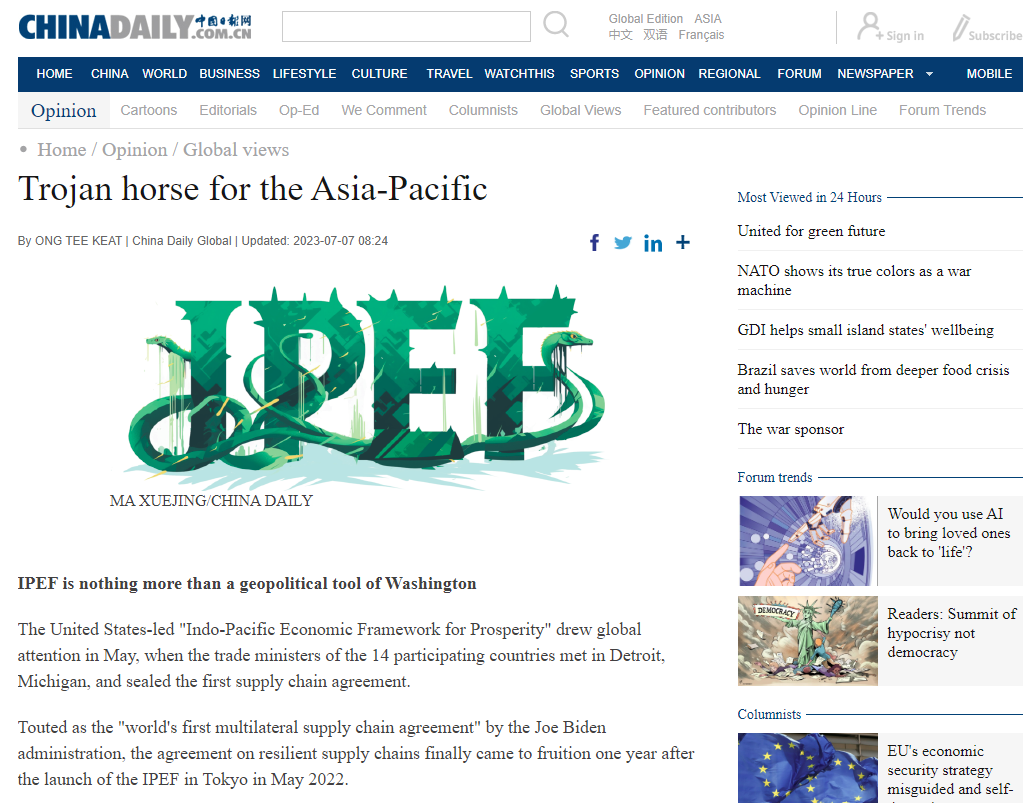LATEST INSIGHTS
Your Present Location: LATEST INSIGHTSONG TEE KEAT: Trojan horse for the Asia-Pacific
Source: CD Published: 2023-07-07

IPEF is nothing more than a geopolitical tool of Washington
The United States-led "Indo-Pacific Economic Framework for Prosperity" drew global attention in May, when the trade ministers of the 14 participating countries met in Detroit, Michigan, and sealed the first supply chain agreement.
Touted as the "world's first multilateral supply chain agreement" by the Joe Biden administration, the agreement on resilient supply chains finally came to fruition one year after the launch of the IPEF in Tokyo in May 2022.
Alongside three other IPEF agreements on trade, clean energy and fair economy which are set to be concluded by November 2023 when the APEC Summit is held, the supply chain agreement underpins the US blueprint for economic engagement with the 13 other participants.
The participating countries have never made any attempt to conceal the implicit intention that this multilateral supply chain deal is intended to act as a check on China's economic influence in the region by creating a multilateral framework parallel to the Regional Comprehensive Economic Partnership in the Asia-Pacific region.
Alongside the US, the members of the IPEF consist of Australia, Brunei, Fiji, India, Indonesia, Japan, the Republic of Korea, Malaysia, New Zealand, the Philippines, Singapore, Thailand and Vietnam. All but the US, India and Fiji are also members of the RCEP.
The high overlapping participation in the two agreements has led to questioning of Washington's purported aim of enhancing economic integration in the Asia-Pacific region through the framework as its duplicating of the RCEP's role is not complementarity in any form.
While the 13 partners continue to be disappointed by the absence of any pledges by Washington on tariff reductions and greater access to the US market, their collective concerns about supply chain resilience are real. The disruption of supply chains worldwide amid the COVID-19 pandemic has spurred the pursuit of supply chain diversification. The US has made use of this amid the rising China-US geopolitical competition by hyping up the risks of over-reliance on China.
After the meeting in Detroit, although the final text remained under wraps, the US Commerce Department was quick to announce that the proposed agreement would establish an emergency communications channel for the IPEF partners to seek support during a future supply chain disruption. It also serves to "facilitate information sharing and collaboration among the IPEF partners during a crisis, enabling a faster and more effective response that minimizes negative effects on their economies".
This seems to address the sore point, but proof of the pudding is in eating. Nobody should draw any conclusion on the proposed crisis response mechanism as yet. Of course, information sharing and collaboration are crucial in addressing any global challenges. Nonetheless, what appears more pressing now is the availability of an alternative supply chain.
Despite that Washington proclaims about the inclusivity of the IPEF, its glaring exclusion of China and the Association of Southeast Asian Nations member states such as Cambodia, Laos and Myanmar, is, by itself, a travesty of inclusiveness.
In reality, China was not spared by the pandemic-induced disruption of supply chains, while the three least developed economies of ASEAN are known to be vulnerable to such impacts. In the event that there's a fresh supply chain disruption, the world could ill-afford to exclude any nation in its concerted bid to address the exigency.
Reading between the lines, it's not difficult to see that the prevailing fear of "supply chain disruption" is merely an excuse exploited by Washington to camouflage its real anguish over the perceived competition posed to the US by China. The least developed trio in ASEAN, viewed as pro-Beijing, are simply "collateral casualties" of the US-initiated endeavor.
US Commerce Secretary Gina Raimondo was quoted as citing shortages of semiconductors during the COVID-19 pandemic that shut down the US auto production, in addition to idling thousands of workers. However, this did not seem to bolster her argument in support of the IPEF supply chain deal in any regard.
The semiconductor supply chain has long been in the grip of the "like-minded allies" of the US, Washington could have marshalled them to mitigate the impact, though not necessarily saving the day, even in the absence of a crisis response mechanism.
The mounting pressure of the US trade and industry associations in demanding strong rules to serve the domestic interests is certainly worth the attention of all the IPEF partners. It comes as a cautioning alarm as it might be the harbinger of a more US-centric IPEF in its implementation.
All in all, the US-led IPEF is nothing more than a geopolitical tool with strong ideological attributes that is intended to insulate the rest of the region from China's supply chain on the pretext of circumventing any potential supply chain disruption. It has never been intended as a trade agreement to facilitate trade liberalization, much less to enhance the regional economic integration in the interest of emerging economies.
Even though the usual dangling carrots of tariff reduction and wider market access still remain nowhere to be sighted in the unfolding development of the IPEF, its developing member states will continue to be wooed by Washington to shore up its waning influence in the Global South.
Key Words: RCEP, US, IPEF, Supply Chain























































































 京公网安备 11010802037854号
京公网安备 11010802037854号





